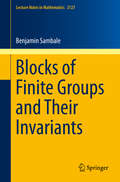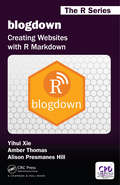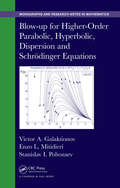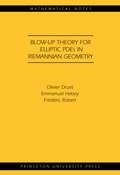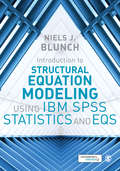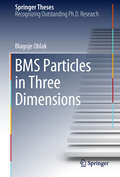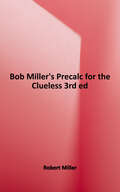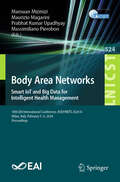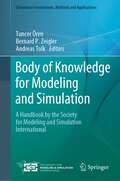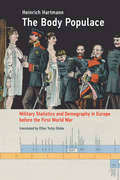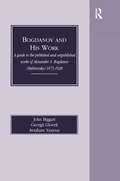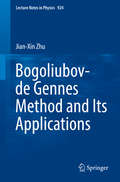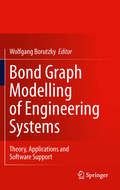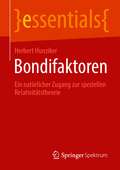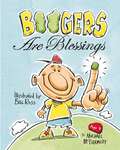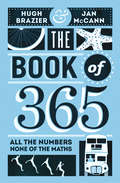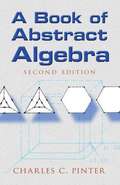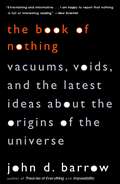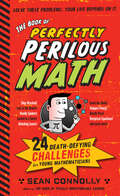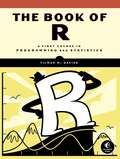- Table View
- List View
Blocks of Finite Groups and Their Invariants (Lecture Notes in Mathematics #2127)
by Benjamin SambaleProviding a nearly complete selection of up-to-date methods and results on block invariants with respect to their defect groups, this book covers the classical theory pioneered by Brauer, the modern theory of fusion systems introduced by Puig, the geometry of numbers developed by Minkowski, the classification of finite simple groups, and various computer assisted methods. In a powerful combination, these tools are applied to solve many special cases of famous open conjectures in the representation theory of finite groups. Most of the material is drawn from peer-reviewed journal articles, but there are also new previously unpublished results. In order to make the text self-contained, detailed proofs are given whenever possible. Several tables add to the text's usefulness as a reference. The book is aimed at experts in group theory or representation theory who may wish to make use of the presented ideas in their research.
blogdown: Creating Websites with R Markdown (Chapman & Hall/CRC The R Series)
by Alison Hill Yihui Xie Amber Thomasblogdown: Creating Websites with R Markdown provides a practical guide for creating websites using the blogdown package in R. In this book, we show you how to use dynamic R Markdown documents to build static websites featuring R code (or other programming languages) with automatically rendered output such as graphics, tables, analysis results, and HTML widgets. The blogdown package is also suitable for technical writing with elements such as citations, footnotes, and LaTeX math. This makes blogdown an ideal platform for any website designed to communicate information about data science, data analysis, data visualization, or R programming. Note that blogdown is not just for blogging or sites about R; it can also be used to create general-purpose websites. By default, blogdown uses Hugo, a popular open-source static website generator, which provides a fast and flexible way to build your site content to be shared online. Other website generators like Jekyll and Hexo are also supported. In this book, you will learn how to: Build a website using the blogdown package; Create blog posts and other website content as dynamic documents that can be easily edited and updated; Customize Hugo templates to suit your site’s needs; Publish your website online; Migrate your existing websites to blogdown and Hugo. Yihui Xie is a software engineer at RStudio. He has authored and co-authored several R packages, including knitr, rmarkdown, bookdown, blogdown, shiny, xaringan, and animation. He has published two other books, Dynamic Documents with R and knitr and bookdown: Authoring Books and Technical Documents with R Markdown. Amber Thomas is a data journalist and "maker" at the online publication of visual essays: The Pudding (https://pudding.cool). Her educational background was marine biology, but she has a strong love of data analysis, visualization, and storytelling. Alison Presmanes Hill is an Associate Professor of Pediatrics at Oregon Health & Science University, where she teaches Computer Science courses on data analysis, data science, and visualization. Her research focuses on using computational methods to study the development of children with neurodevelopmental disorders, in particular Autism Spectrum Disorders.
Blow-up for Higher-Order Parabolic, Hyperbolic, Dispersion and Schrodinger Equations (Chapman & Hall/CRC Monographs and Research Notes in Mathematics)
by Victor A. Galaktionov Enzo L. Mitidieri Stanislav I. PohozaevBlow-up for Higher-Order Parabolic, Hyperbolic, Dispersion and Schrodinger Equations shows how four types of higher-order nonlinear evolution partial differential equations (PDEs) have many commonalities through their special quasilinear degenerate representations. The authors present a unified approach to deal with these quasilinear PDEs.The book
Blow-up Theory for Elliptic PDEs in Riemannian Geometry (Mathematical Notes #45)
by Olivier Druet Emmanuel Hebey Frédéric RobertElliptic equations of critical Sobolev growth have been the target of investigation for decades because they have proved to be of great importance in analysis, geometry, and physics. The equations studied here are of the well-known Yamabe type. They involve Schrödinger operators on the left hand side and a critical nonlinearity on the right hand side. A significant development in the study of such equations occurred in the 1980s. It was discovered that the sequence splits into a solution of the limit equation--a finite sum of bubbles--and a rest that converges strongly to zero in the Sobolev space consisting of square integrable functions whose gradient is also square integrable. This splitting is known as the integral theory for blow-up. In this book, the authors develop the pointwise theory for blow-up. They introduce new ideas and methods that lead to sharp pointwise estimates. These estimates have important applications when dealing with sharp constant problems (a case where the energy is minimal) and compactness results (a case where the energy is arbitrarily large). The authors carefully and thoroughly describe pointwise behavior when the energy is arbitrary. Intended to be as self-contained as possible, this accessible book will interest graduate students and researchers in a range of mathematical fields.
The Blue Book: Smart sustainable coastal cities and blue growth strategies for marine and maritime environments
by Stamatina Th. RassiaThis volume offers a wealth of results written by experts from interdisciplinary fields, contributing on a diversity of topics targeting marine and maritime environmental sustainability in coastal and ocean-related areas. The reader will benefit from the diversity and breadth of topical coverage as well as concepts conveyed from a variety researchers. The book serves as an open knowledge platform combining many aspects of SDG #11 including naval architecture and marine engineering, ecology, biomedical informatics, public health, architecture engineering and building physics, nanotechnology as well as advanced technologies, innovation and related fields. The broad range of topics cover ecology, shipping, and health related issues. Specifically, the book presents chapters on the following: · Shipping and ecology · Topics of ocean wildlife and mega-fauna protection · Big Data and sustainable applications for healthy and safe coastal cities · Smart sustainable humanitarian assistance methods using large vessels · Smart coastal city tourist activity, mobility management · Urban climate condition mitigation · Historical analysis of the case of disease outbreaks onboard ships · Monitoring, simulating and decision making while developing housing at sea, such as in cruise-ships · Conducting feasibility assessment for outbreak prevention following real-time, systematic disease detection on cruise ships · Technological approaches for cruise ship disease propagation monitoring · Scenario testing for sensors and actuators deployment to prevent and mitigate epidemics on cruise ships, as well as methods for improving biological safety on ships using nanotechnology The book is expected to engage researchers in multidisciplinary areas as well as students and interested readers.
Blueprint Reading for Welders and Fitters: programmed instructions
by HobartThis program is designed to give you a thorough understanding of blueprints such that you can interpret exactly what a designer requires.
Blunch. Introduction to Structural Equation Modeling using IBM SPSS Statistics and EQS
by Niels J. BlunchThis student orientated guide to structural equation modeling promotes theoretical understanding and inspires studentswith the confidenceto successfully apply SEM. Assuming no previous experience, and a minimum of mathematical knowledge, this is an invaluable companion for students taking introductory SEM courses in any discipline. Niels Blunch shines a light on each step of the structural equation modeling process, providing a detailed introduction to SPSS and EQS with a focus on EQS' excellent graphical interface. He also sets out best practice for data entry and programming, and uses real life data to show how SEM is applied in research. The book includes: Learning objectives, key concepts and questions for further discussion in each chapter. Helpful diagrams and screenshots to expand on concepts covered in the texts. A wide variety of examples from multiple disciplines and real world contexts. Exercises for each chapter on an accompanyingcompanion website. A detailed glossary. Clear, engaging and built around key software, this is an ideal introduction for anyone new to SEM. "
BMS Particles in Three Dimensions (Springer Theses)
by Blagoje OblakThis thesis presents the state of the art in the study of Bondi-Metzner-Sachs (BMS) symmetry and its applications in the simplified setting of three dimensions. It focuses on presenting all the background material in a pedagogical and self-contained manner to enable readers to fully appreciate the original results that have been obtained while learning a number of fundamental concepts in the field along the way. This makes it a highly rewarding read and a perfect starting point for anybody with a serious interest in the four-dimensional problem.
Bob Miller's Precalc for The Clueless Precalc with Trigonometry, Third Edition
by Robert MillerBob Miller's PreCalc for the Clueless, Third Edition, is jam-packed with tips, techniques, and surefire strategies to help students understand and advance in this challenging subject. In this third edition, new features include: - Recent changes in the precalculus pedagogy implemented over the past seven years - New sections explaining the fundamentals of algebra and trigonometry - A new chapter on induction - All the math needed for the new SAT - Sample problems for every technique and topic
Bob Ross: My First Book of Numbers (My First Bob Ross Books)
by Robb PearlmanToddlers will learn their numbers and basic counting skills with Bob Ross and his 13 paints in this early concept board book. Count your way to thirteen in this serene and peaceful early concept board book in the Bob Ross My First Book series, which includes Bob Ross: My First Book of Colors and Bob Ross: My First Book of Nature! Count one bright moon, two friends, three (then four) trees, five rocks, and more with iconic painter Bob Ross as he quips and reminds you to take things slowly. Illustrated using real paintings created by Bob Ross, this is a perfect board book for fans young and old alike! Copyright © 2023 by Bob Ross Inc. ®Bob Ross name and images are registered trademarks of Bob Ross Inc. © Bob Ross Inc. Used with Permission. All rights reserved.
Body Area Networks. Smart IoT and Big Data for Intelligent Health Management: 18th EAI International Conference, BODYNETS 2024-A, Milan, Italy, February 5-6, 2024, Proceedings (Lecture Notes of the Institute for Computer Sciences, Social Informatics and Telecommunications Engineering #524)
by Marouan Mizmizi Maurizio Magarini Prabhat Kumar Upadhyay Massimiliano PierobonThis book constitutes the refereed post-conference proceedings from the 18th EAI International Conference on Body Area Networks, BODYNETS 2024-A, held in Milan, Italy, in February 5-6, 2024. The 20 full papers presented here were carefully reviewed and selected from 48 submissions. These papers have been organized in the following topical sections: Implantable devices and In-body communication; Body area networks and transmission technologies; Smart healthcare applications; Privacy and security in wireless body area networks.
Body of Knowledge for Modeling and Simulation: A Handbook by the Society for Modeling and Simulation International (Simulation Foundations, Methods and Applications)
by Tuncer Ören Bernard P. Zeigler Andreas TolkCommissioned by the Society for Modeling and Simulation International (SCS), this needed, useful new ‘Body of Knowledge’ (BoK) collects and organizes the common understanding of a wide collection of professionals and professional associations.Modeling and simulation (M&S) is a ubiquitous discipline that lays the computational foundation for real and virtual experimentation, clearly stating boundaries—and interactions—of systems, data, and representations. The field is well known, too, for its training support via simulations and simulators. Indeed, with computers increasingly influencing the activities of today’s world, M&S is the third pillar of scientific understanding, taking its place along with theory building and empirical observation.This valuable new handbook provides intellectual support for all disciplines in analysis, design and optimization. It contributes increasingly to the growing number of computational disciplines, addressing the broad variety of contributing as well as supported disciplines and application domains. Further, each of its sections provide numerous references for further information. Highly comprehensive, the BoK represents many viewpoints and facets, captured under such topics as:Mathematical and Systems Theory FoundationsSimulation Formalisms and ParadigmsSynergies with Systems Engineering and Artificial IntelligenceMultidisciplinary ChallengesEthics and PhilosophyHistorical PerspectivesExamining theoretical as well as practical challenges, this unique volume addresses the many facets of M&S for scholars, students, and practitioners. As such, it affords readers from all science, engineering, and arts disciplines a comprehensive and concise representation of concepts, terms, and activities needed to explain the M&S discipline.Tuncer Ören is Professor Emeritus at the University of Ottawa. Bernard Zeigler is Professor Emeritus at the University of Arizona. Andreas Tolk is Chief Scientist at The MITRE Corporation. All three editors are long-time members and Fellows of the Society for Modeling and Simulation International. Under the leadership of three SCS Fellows, Dr. Ören, University of Ottawa, Dr. Zeigler, The University of Arizona, and Dr. Tolk, The MITRE Corporation, more than 50 international scholars from 15 countries provided insights and experience to compile this initial M&S Body of Knowledge.
The Body Populace: Military Statistics and Demography in Europe before the First World War (Transformations: Studies in the History of Science and Technology)
by Heinrich HartmannHow data gathered from national conscriptions in pre–World War I Europe influenced understandings of population fitness and redefined society as a collective body. In pre–World War I Europe, individual fitness was increasingly related to building and preserving collective society. Army recruitment offered the most important opportunity to screen male citizens' fitness, raising questions of how to define fitness for soldiers and how to translate this criteria outside the military context. In this book, Heinrich Hartmann explores the historical circumstances that shaped collective understandings of fitness in Europe before World War I and how these were intertwined with a fear of demographic decline and degeneration. This dynamic gained momentum through the circulation of knowledge among European nations, but also through the scenarios of military confrontations. Hartmann provides a science history of military statistics in Germany, France, and Switzerland in the decades preceding World War I, considering how information gathered during national conscriptions generated data about the health and fitness of the population. Defined by masculine concepts, conscription examinations went far beyond the individuals they tested and measured. Scholars of the time aspired to pin down the “nation” in concrete numerical terms, drawing on data from examinations to redefine society as a “collective body” that could be counted, measured, and examined. The Body Populace explores the historical specificity and contingency of data-gathering techniques, recounts their uses and abuses, and provides a timely contribution to the growing historiography of Big Data. It sheds light on a crucial moment in nineteenth and early twentieth century European history—when statistical data and demographical knowledge shaped new notions of masculinity, fostered fears of degeneration, and gave rise to eugenic thinking.
Bogdanov and His Work: A Guide to the Published and Unpublished Works of Alexander A Bogdanov (Malinovsky) 1873-1928
by John Biggart Georgii GloveliAlexander Bogdanov was a co-founder, with Lenin, of the Bolshevik faction of the Russian Social Democratic Party in 1904. After 1905, Bogdanov criticized Lenin's adaption of Bolshevism to the requirements of Duma politics and his authoritarian style of leadership. Expelled from the Bolshevik fraction in 1909, he at first formed the Forward faction of the RSDRP and then turned increasingly to scholarly and publicistic work. In 1910 he published Faith and Science, replying to Lenin's Materialism and Empiriocritcism, which had been written to discredit him. His ideas on the sociology of culture led to the founding of the Proletkult in 1917 and during the 1920s these ideas were taken up, adapted and often distorted in the course of the 'Cultural Revolution'. Bogdanov's textbooks in sociology and economics were widely used during the 1920s. Seeking to liberate Marxism from the shackles of Hegelianism, he developed a theory of 'organizational science' ('Tektology') which influenced early economic planning through the work of Groman and Bazarov. As a systems thinker, Bogdanov is now viewed as a precursor of Ludwig von Berthalanffy and Norbert Wiener. Arrested by the GPU in 1923, for alleged political opposition, Bogdanov withdrew even further from public life and returned to medicine, his original calling. In 1926 he founded the first Russian Institute of Blood Transfusion, presiding over pioneering work in this sphere until 1928 when he died. During the Stalin years, Bogdanov's works were judged to be heretical and were not republished. It was not until 1989 that his 'Universal Organizational Science' was republished, though his contribution to systems thinking had been recognized by Russian and East European systems thinkers as early as the 1960s. In the West. the importance of Bogdanov as a 'cultural Marxist', as an influence upon Gramsci, and as a pioneer in systems thinking, is increasingly being acknowledged. This bibliography of Bogdanov's works takes advantage of the opening of the Party and State archives and provides references to the principal relevant archives in Europe and the United States. Its publication is a landmark in the history of Bolshevism and in the history of Russian social thought.
Bogoliubov-de Gennes Method and Its Applications (Lecture Notes in Physics #924)
by Jian-Xin ZhuThe purpose of this book is to provide an elementary yet systematic description of the Bogoliubov-de Gennes (BdG) equations, their unique symmetry properties and their relation to Green's function theory. Specifically, it introduces readers to the supercell technique for the solutions of the BdG equations, as well as other related techniques for more rapidly solving the equations in practical applications. The BdG equations are derived from a microscopic model Hamiltonian with an effective pairing interaction and fully capture the local electronic structure through self-consistent solutions via exact diagonalization. This approach has been successfully generalized to study many aspects of conventional and unconventional superconductors with inhomogeneities - including defects, disorder or the presence of a magnetic field - and becomes an even more attractive choice when the first-principles information of a typical superconductor is incorporated via the construction of a low-energy tight-binding model. Further, the lattice BdG approach is essential when theoretical results for local electronic states around such defects are compared with the scanning tunneling microscopy measurements. Altogether, these lectures provide a timely primer for graduate students and non-specialist researchers, while also offering a useful reference guide for experts in the field.
Bond Graph Modelling of Engineering Systems: Theory, Applications and Software Support
by Wolfgang BorutzkyThe author presents current work in bond graph methodology by providing a compilation of contributions from experts across the world that covers theoretical topics, applications in various areas as well as software for bond graph modeling. It addresses readers in academia and in industry concerned with the analysis of multidisciplinary engineering systems or control system design who are interested to see how latest developments in bond graph methodology with regard to theory and applications can serve their needs in their engineering fields. This presentation of advanced work in bond graph modeling presents the leading edge of research in this field. It is hoped that it stimulates new ideas with regard to further progress in theory and in applications.
Bondifaktoren: Ein natürlicher Zugang zur speziellen Relativitätstheorie (essentials)
by Herbert HunzikerObwohl Albert Einstein die spezielle Relativitätstheorie vor mehr als hundert Jahren verfasst hat, ist ihre Vermittlung bis heute eine Herausforderung geblieben. Die dabei auftretenden Schwierigkeiten sind nicht mathematischer Art, sie sind vielmehr darin begründet, dass vertraute Vorstellungen über Raum und Zeit aufzugeben sind. So etwa gilt es zu akzeptieren, dass die zeitliche Reihenfolge von Ereignissen nicht absolut, sondern gemäss Einstein beobachterabhängig ist. Es darf deshalb als Glücksfall betrachtet werden, dass Hermann Bondi in den sechziger Jahren des vorigen Jahrhunderts einen Zugang zur SRT beschrieben hat, der auf einer ausgesprochen intuitiv geprägten Begriffsbildung basiert. In der vorliegenden Schrift wird dieser Zugang dargestellt und erweitert.
BONUS Algorithm for Large Scale Stochastic Nonlinear Programming Problems (SpringerBriefs in Optimization)
by Urmila Diwekar Amy DavidThis book presents the details of the BONUS algorithm and its real world applications in areas like sensor placement in large scale drinking water networks, sensor placement in advanced power systems, water management in power systems, and capacity expansion of energy systems. A generalized method for stochastic nonlinear programming based on a sampling based approach for uncertainty analysis and statistical reweighting to obtain probability information is demonstrated in this book. Stochastic optimization problems are difficult to solve since they involve dealing with optimization and uncertainty loops. There are two fundamental approaches used to solve such problems. The first being the decomposition techniques and the second method identifies problem specific structures and transforms the problem into a deterministic nonlinear programming problem. These techniques have significant limitations on either the objective function type or the underlying distributions for the uncertain variables. Moreover, these methods assume that there are a small number of scenarios to be evaluated for calculation of the probabilistic objective function and constraints. This book begins to tackle these issues by describing a generalized method for stochastic nonlinear programming problems. This title is best suited for practitioners, researchers and students in engineering, operations research, and management science who desire a complete understanding of the BONUS algorithm and its applications to the real world.
Boogers Are Blessings
by Michael McdermottHilarious and educational, Boogers Are Blessings will have your child counting and giggling along with its mischievous host, whose mission is to inform the world of all of the glorious qualities of boogers. This little boy knows the importance of counting his blessings, and he does so-in a way that only little boys can. Along with teaching your child to count from one to ten, he reminds us that each and every piece of God's creation is wonderful-even the slimy ones.
Book Keeping And Accountancy class 12 - Maharashtra Board
by Maharashtra State Bureau of Textbook Production and Curriculum ResearchCreated by the Maharashtra State Bureau of Textbook Production and Curriculum Research, the textbook for class 12 covers topics related to Sole Proprietorship firm and basic accounting concepts. Syllabus covers topics related to Partnership Firm, Not for Profit Organization, Accounting of Company Accounts-Issue of Shares, Financial Statement Analysis, Bills of Exchange and Computer in Accounting. Due care has been taken to present the subject matter in a simple manner so that the students can easily understand the relating accounting concepts and contents. Similarly the students who do not have a commerce background but are going to pursue further education in commerce the text book will be of great help to understand the subject in a lucid manner. Various practical problems based on skill and application are included in the textbook. The exercises given at the end of each topic contains different types of questions to test conceptual clarity and accuracy and encourage the students to cultivate the skills and applications required for their future education.
The Book of 365: All the Numbers, None of the Maths
by Hugh Brazier Jan McCannEver wondered how many dimples there are on a golf ball; or why the shipping forecast is broadcast on 198 kHz long wave? Find yourself puzzling over what is really going on in the 273 seconds of John Cage’s most famous composition? Then this book of mind-boggling number facts is for you.The Book of 365 offers an entertaining and thought-provoking mini-essay on the world around us for every day of the year, each taking a number between 1 and 365 as its starting point, encompassing science, history, art, literature, medicine, and popular culture, and covering topics as diverse as modern music and meteorites, archaeology and chilli sauce, un-birthdays and radio valve technology.On the way, uncover:At 5, the pentaradial symmetry of starfish and rosesAt 34, how the US flag got its stars and stripesAt 99, the mysteries of the 99 ice-creamAt 239, where Sherlock Holmes really livedAnd, in honour of the leap year, at the end of the book there is a bonus 366th essay!
A Book Of Abstract Algebra
by Charles PinterAccessible but rigorous, this outstanding text encompasses all of the topics covered by a typical course in elementary abstract algebra. Its easy-to-read treatment offers an intuitive approach, featuring informal discussions followed by thematically arranged exercises. Intended for undergraduate courses in abstract algebra, it is suitable for junior- and senior-level math majors and future math teachers. This second edition features additional exercises to improve student familiarity with applications. <p><p> An introductory chapter traces concepts of abstract algebra from their historical roots. Succeeding chapters avoid the conventional format of definition-theorem-proof-corollary-example; instead, they take the form of a discussion with students, focusing on explanations and offering motivation. Each chapter rests upon a central theme, usually a specific application or use. The author provides elementary background as needed and discusses standard topics in their usual order. He introduces many advanced and peripheral subjects in the plentiful exercises, which are accompanied by ample instruction and commentary and offer a wide range of experiences to students at different levels of ability.
The Book of Nothing: Vacuums, Voids, and the Latest Ideas about the Origins of the Universe
by John D. BarrowWhat conceptual blind spot kept the ancient Greeks (unlike the Indians and Maya) from developing a concept of zero? Why did St. Augustine equate nothingness with the Devil? What tortuous means did 17th-century scientists employ in their attempts to create a vacuum? And why do contemporary quantum physicists believe that the void is actually seething with subatomic activity? You’ll find the answers in this dizzyingly erudite and elegantly explained book by the English cosmologist John D. Barrow. Ranging through mathematics, theology, philosophy, literature, particle physics, and cosmology,The Book of Nothingexplores the enduring hold that vacuity has exercised on the human imagination. Combining high-wire speculation with a wealth of reference that takes in Freddy Mercury and Shakespeare alongside Isaac Newton, Albert Einstein, and Stephen Hawking, the result is a fascinating excursion to the vanishing point of our knowledge.
The Book of Perfectly Perilous Math: 24 Death-Defying Challenges for Young Mathematicians (Irresponsible Science)
by Sean ConnollyMath rocks! At least it does in the gifted hands of Sean Connolly, who blends middle school math with fantasy to create an exciting adventure in problem-solving. These word problems are perilous, do-or-die scenarios of blood-sucking vampires (How many months would it take a single vampire to completely take over a town of 500,000 people?), or a rowboat of 5 shipwrecked sailors with a single barrel of freshwater (How much can they drink, and for how long, before they go mad from thirst???). Each problem requires readers to dig deep into the tools they’re learning in school to figure out how to survive.Kids will love solving these problems. Sean Connolly knows how to make tough subjects exciting and he brings that same intuitive understanding of what inspires and challenges kids’ curiosity to the 24 problems in The Book of Perfectly Perilous Math. These problems are as fun to read as they are challenging to solve. They test readers on fractions, algebra, geometry, probability, expressions and equations, and more.Use geometry to fill in for the ship’s navigator and make it safely to the New World. Escape an evil Duke’s executioner by picking the right door—probability will save your neck.
The Book of R: A First Course in Programming and Statistics
by Tilman M. DaviesThe Book of R is a comprehensive, beginner-friendly guide to R, the world’s most popular programming language for statistical analysis. Even if you have no programming experience and little more than a grounding in the basics of mathematics, you’ll find everything you need to begin using R effectively for statistical analysis.You’ll start with the basics, like how to handle data and write simple programs, before moving on to more advanced topics, like producing statistical summaries of your data and performing statistical tests and modeling. You’ll even learn how to create impressive data visualizations with R’s basic graphics tools and contributed packages, like ggplot2 and ggvis, as well as interactive 3D visualizations using the rgl package.Dozens of hands-on exercises (with downloadable solutions) take you from theory to practice, as you learn:–The fundamentals of programming in R, including how to write data frames, create functions, and use variables, statements, and loops–Statistical concepts like exploratory data analysis, probabilities, hypothesis tests, and regression modeling, and how to execute them in R–How to access R’s thousands of functions, libraries, and data sets–How to draw valid and useful conclusions from your data–How to create publication-quality graphics of your resultsCombining detailed explanations with real-world examples and exercises, this book will provide you with a solid understanding of both statistics and the depth of R’s functionality. Make The Book of R your doorway into the growing world of data analysis.
